Leading Lean Projects
VerifiedAdded on 2022/11/28
|12
|3513
|51
AI Summary
This document discusses the process of leading lean projects and implementing lean project management for building a dream home. It covers the selection of the suburb and land size, the chosen builder, and the identification of project stakeholders. It also explores the factors that influence the design and layout of the house and the project management process determined for the project. Additionally, it explains the implementation of lean best practices to achieve lean project management for the dream house project.
Contribute Materials
Your contribution can guide someone’s learning journey. Share your
documents today.

Running head: LEADING LEAN PROJECTS
PPMP20009 Leading Lean Projects Assessment 1
Implementing lean project management to build your dream home
Name of the student:
Name of the University:
PPMP20009 Leading Lean Projects Assessment 1
Implementing lean project management to build your dream home
Name of the student:
Name of the University:
Secure Best Marks with AI Grader
Need help grading? Try our AI Grader for instant feedback on your assignments.
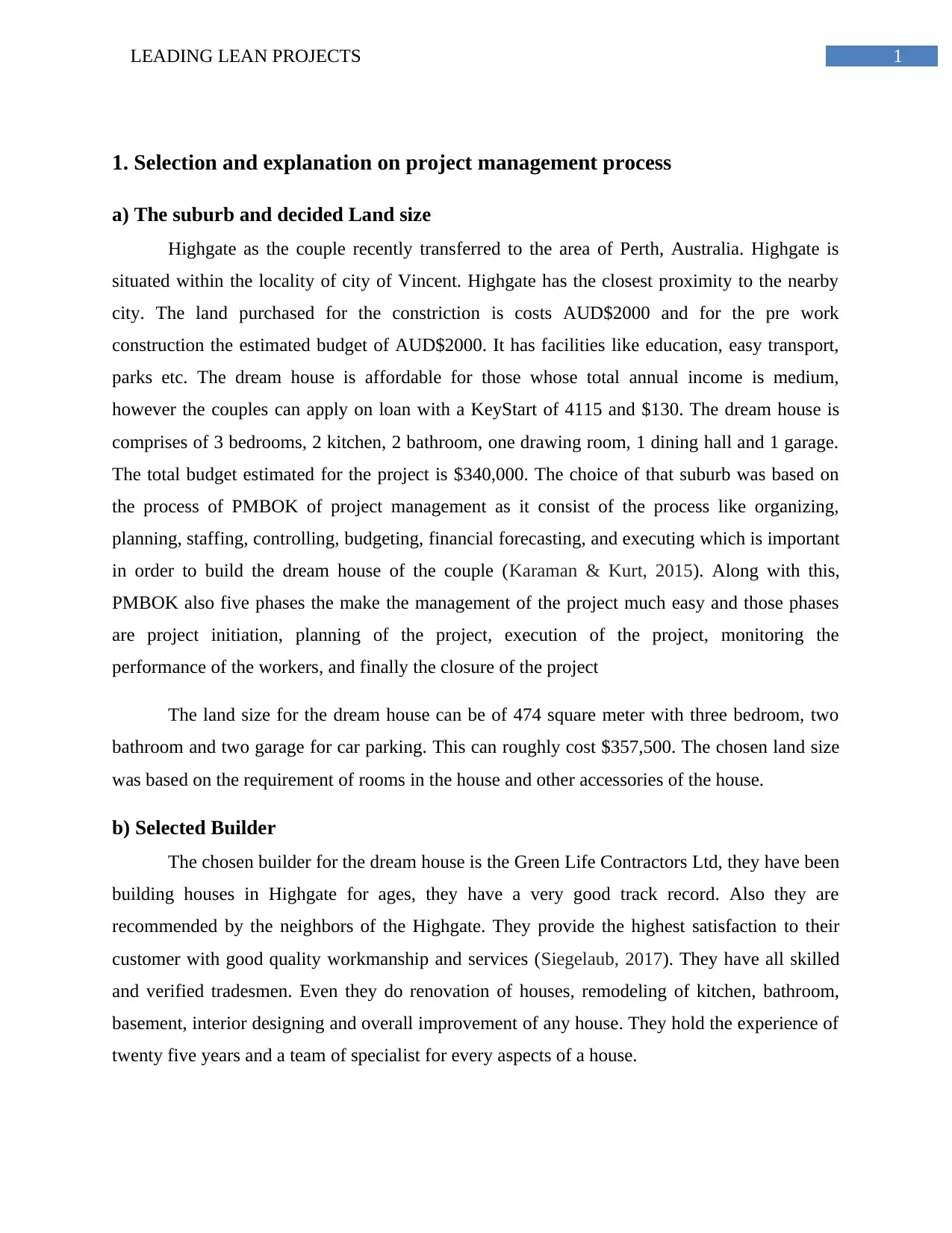
1LEADING LEAN PROJECTS
1. Selection and explanation on project management process
a) The suburb and decided Land size
Highgate as the couple recently transferred to the area of Perth, Australia. Highgate is
situated within the locality of city of Vincent. Highgate has the closest proximity to the nearby
city. The land purchased for the constriction is costs AUD$2000 and for the pre work
construction the estimated budget of AUD$2000. It has facilities like education, easy transport,
parks etc. The dream house is affordable for those whose total annual income is medium,
however the couples can apply on loan with a KeyStart of 4115 and $130. The dream house is
comprises of 3 bedrooms, 2 kitchen, 2 bathroom, one drawing room, 1 dining hall and 1 garage.
The total budget estimated for the project is $340,000. The choice of that suburb was based on
the process of PMBOK of project management as it consist of the process like organizing,
planning, staffing, controlling, budgeting, financial forecasting, and executing which is important
in order to build the dream house of the couple (Karaman & Kurt, 2015). Along with this,
PMBOK also five phases the make the management of the project much easy and those phases
are project initiation, planning of the project, execution of the project, monitoring the
performance of the workers, and finally the closure of the project
The land size for the dream house can be of 474 square meter with three bedroom, two
bathroom and two garage for car parking. This can roughly cost $357,500. The chosen land size
was based on the requirement of rooms in the house and other accessories of the house.
b) Selected Builder
The chosen builder for the dream house is the Green Life Contractors Ltd, they have been
building houses in Highgate for ages, they have a very good track record. Also they are
recommended by the neighbors of the Highgate. They provide the highest satisfaction to their
customer with good quality workmanship and services (Siegelaub, 2017). They have all skilled
and verified tradesmen. Even they do renovation of houses, remodeling of kitchen, bathroom,
basement, interior designing and overall improvement of any house. They hold the experience of
twenty five years and a team of specialist for every aspects of a house.
1. Selection and explanation on project management process
a) The suburb and decided Land size
Highgate as the couple recently transferred to the area of Perth, Australia. Highgate is
situated within the locality of city of Vincent. Highgate has the closest proximity to the nearby
city. The land purchased for the constriction is costs AUD$2000 and for the pre work
construction the estimated budget of AUD$2000. It has facilities like education, easy transport,
parks etc. The dream house is affordable for those whose total annual income is medium,
however the couples can apply on loan with a KeyStart of 4115 and $130. The dream house is
comprises of 3 bedrooms, 2 kitchen, 2 bathroom, one drawing room, 1 dining hall and 1 garage.
The total budget estimated for the project is $340,000. The choice of that suburb was based on
the process of PMBOK of project management as it consist of the process like organizing,
planning, staffing, controlling, budgeting, financial forecasting, and executing which is important
in order to build the dream house of the couple (Karaman & Kurt, 2015). Along with this,
PMBOK also five phases the make the management of the project much easy and those phases
are project initiation, planning of the project, execution of the project, monitoring the
performance of the workers, and finally the closure of the project
The land size for the dream house can be of 474 square meter with three bedroom, two
bathroom and two garage for car parking. This can roughly cost $357,500. The chosen land size
was based on the requirement of rooms in the house and other accessories of the house.
b) Selected Builder
The chosen builder for the dream house is the Green Life Contractors Ltd, they have been
building houses in Highgate for ages, they have a very good track record. Also they are
recommended by the neighbors of the Highgate. They provide the highest satisfaction to their
customer with good quality workmanship and services (Siegelaub, 2017). They have all skilled
and verified tradesmen. Even they do renovation of houses, remodeling of kitchen, bathroom,
basement, interior designing and overall improvement of any house. They hold the experience of
twenty five years and a team of specialist for every aspects of a house.
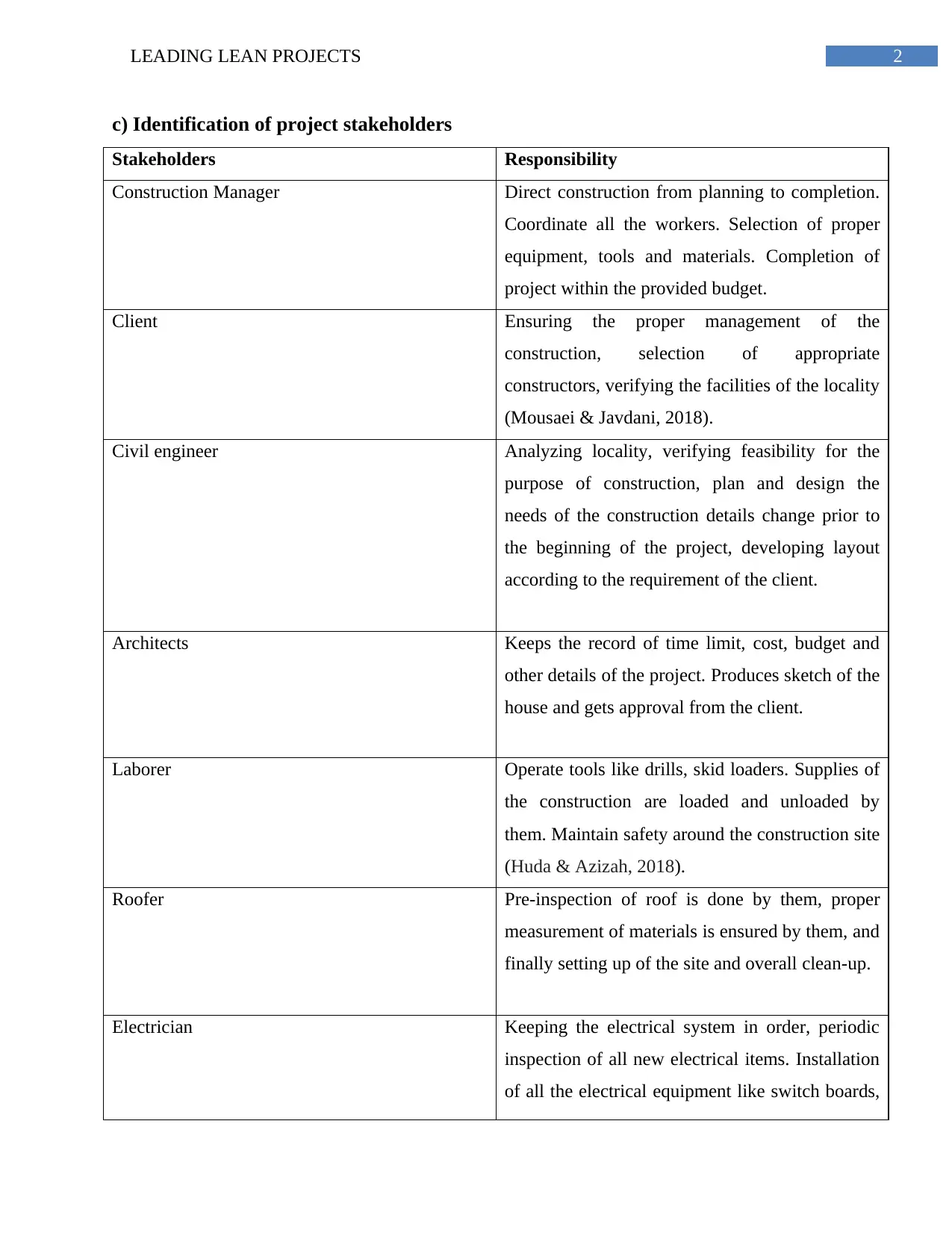
2LEADING LEAN PROJECTS
c) Identification of project stakeholders
Stakeholders Responsibility
Construction Manager Direct construction from planning to completion.
Coordinate all the workers. Selection of proper
equipment, tools and materials. Completion of
project within the provided budget.
Client Ensuring the proper management of the
construction, selection of appropriate
constructors, verifying the facilities of the locality
(Mousaei & Javdani, 2018).
Civil engineer Analyzing locality, verifying feasibility for the
purpose of construction, plan and design the
needs of the construction details change prior to
the beginning of the project, developing layout
according to the requirement of the client.
Architects Keeps the record of time limit, cost, budget and
other details of the project. Produces sketch of the
house and gets approval from the client.
Laborer Operate tools like drills, skid loaders. Supplies of
the construction are loaded and unloaded by
them. Maintain safety around the construction site
(Huda & Azizah, 2018).
Roofer Pre-inspection of roof is done by them, proper
measurement of materials is ensured by them, and
finally setting up of the site and overall clean-up.
Electrician Keeping the electrical system in order, periodic
inspection of all new electrical items. Installation
of all the electrical equipment like switch boards,
c) Identification of project stakeholders
Stakeholders Responsibility
Construction Manager Direct construction from planning to completion.
Coordinate all the workers. Selection of proper
equipment, tools and materials. Completion of
project within the provided budget.
Client Ensuring the proper management of the
construction, selection of appropriate
constructors, verifying the facilities of the locality
(Mousaei & Javdani, 2018).
Civil engineer Analyzing locality, verifying feasibility for the
purpose of construction, plan and design the
needs of the construction details change prior to
the beginning of the project, developing layout
according to the requirement of the client.
Architects Keeps the record of time limit, cost, budget and
other details of the project. Produces sketch of the
house and gets approval from the client.
Laborer Operate tools like drills, skid loaders. Supplies of
the construction are loaded and unloaded by
them. Maintain safety around the construction site
(Huda & Azizah, 2018).
Roofer Pre-inspection of roof is done by them, proper
measurement of materials is ensured by them, and
finally setting up of the site and overall clean-up.
Electrician Keeping the electrical system in order, periodic
inspection of all new electrical items. Installation
of all the electrical equipment like switch boards,
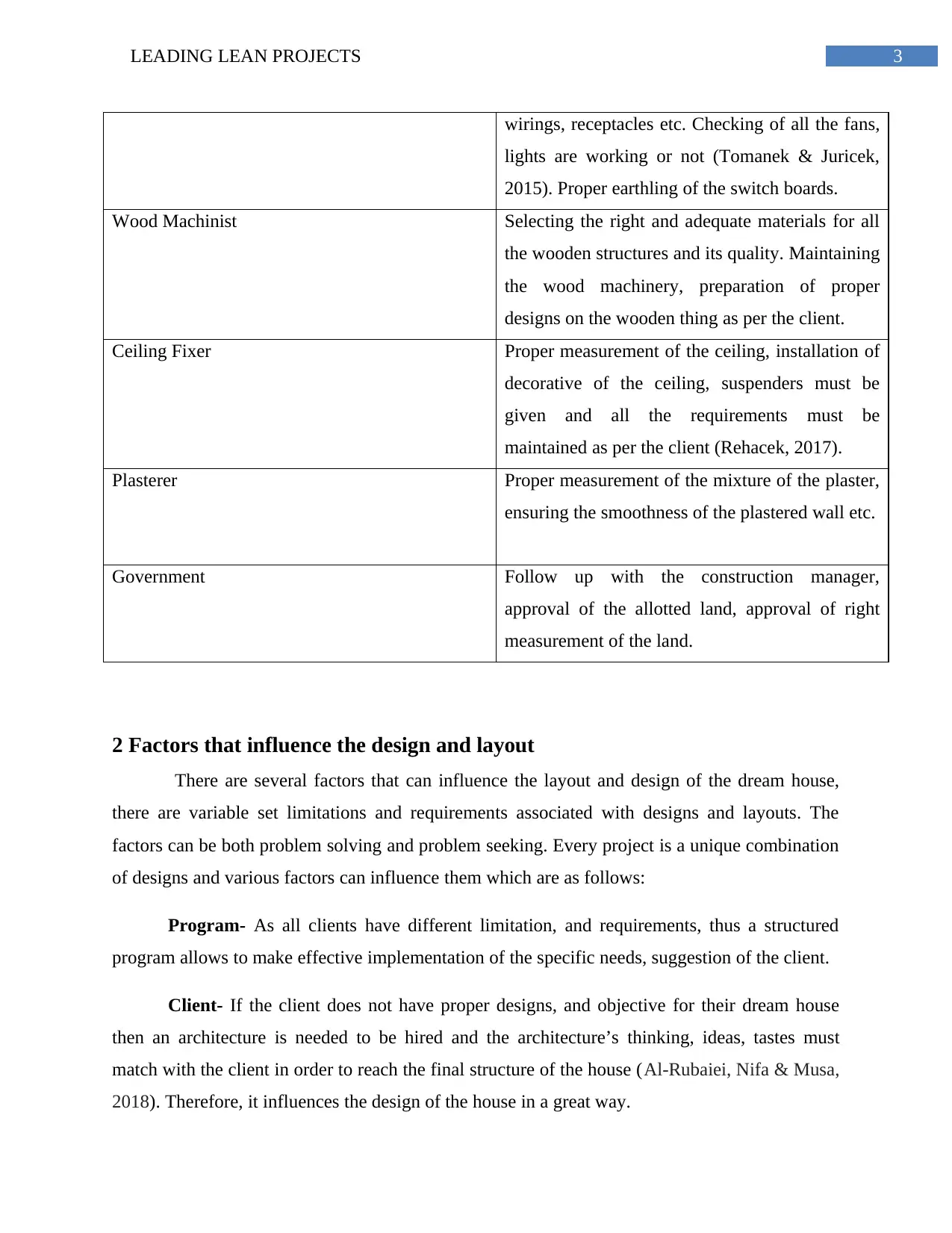
3LEADING LEAN PROJECTS
wirings, receptacles etc. Checking of all the fans,
lights are working or not (Tomanek & Juricek,
2015). Proper earthling of the switch boards.
Wood Machinist Selecting the right and adequate materials for all
the wooden structures and its quality. Maintaining
the wood machinery, preparation of proper
designs on the wooden thing as per the client.
Ceiling Fixer Proper measurement of the ceiling, installation of
decorative of the ceiling, suspenders must be
given and all the requirements must be
maintained as per the client (Rehacek, 2017).
Plasterer Proper measurement of the mixture of the plaster,
ensuring the smoothness of the plastered wall etc.
Government Follow up with the construction manager,
approval of the allotted land, approval of right
measurement of the land.
2 Factors that influence the design and layout
There are several factors that can influence the layout and design of the dream house,
there are variable set limitations and requirements associated with designs and layouts. The
factors can be both problem solving and problem seeking. Every project is a unique combination
of designs and various factors can influence them which are as follows:
Program- As all clients have different limitation, and requirements, thus a structured
program allows to make effective implementation of the specific needs, suggestion of the client.
Client- If the client does not have proper designs, and objective for their dream house
then an architecture is needed to be hired and the architecture’s thinking, ideas, tastes must
match with the client in order to reach the final structure of the house (Al-Rubaiei, Nifa & Musa,
2018). Therefore, it influences the design of the house in a great way.
wirings, receptacles etc. Checking of all the fans,
lights are working or not (Tomanek & Juricek,
2015). Proper earthling of the switch boards.
Wood Machinist Selecting the right and adequate materials for all
the wooden structures and its quality. Maintaining
the wood machinery, preparation of proper
designs on the wooden thing as per the client.
Ceiling Fixer Proper measurement of the ceiling, installation of
decorative of the ceiling, suspenders must be
given and all the requirements must be
maintained as per the client (Rehacek, 2017).
Plasterer Proper measurement of the mixture of the plaster,
ensuring the smoothness of the plastered wall etc.
Government Follow up with the construction manager,
approval of the allotted land, approval of right
measurement of the land.
2 Factors that influence the design and layout
There are several factors that can influence the layout and design of the dream house,
there are variable set limitations and requirements associated with designs and layouts. The
factors can be both problem solving and problem seeking. Every project is a unique combination
of designs and various factors can influence them which are as follows:
Program- As all clients have different limitation, and requirements, thus a structured
program allows to make effective implementation of the specific needs, suggestion of the client.
Client- If the client does not have proper designs, and objective for their dream house
then an architecture is needed to be hired and the architecture’s thinking, ideas, tastes must
match with the client in order to reach the final structure of the house (Al-Rubaiei, Nifa & Musa,
2018). Therefore, it influences the design of the house in a great way.
Secure Best Marks with AI Grader
Need help grading? Try our AI Grader for instant feedback on your assignments.
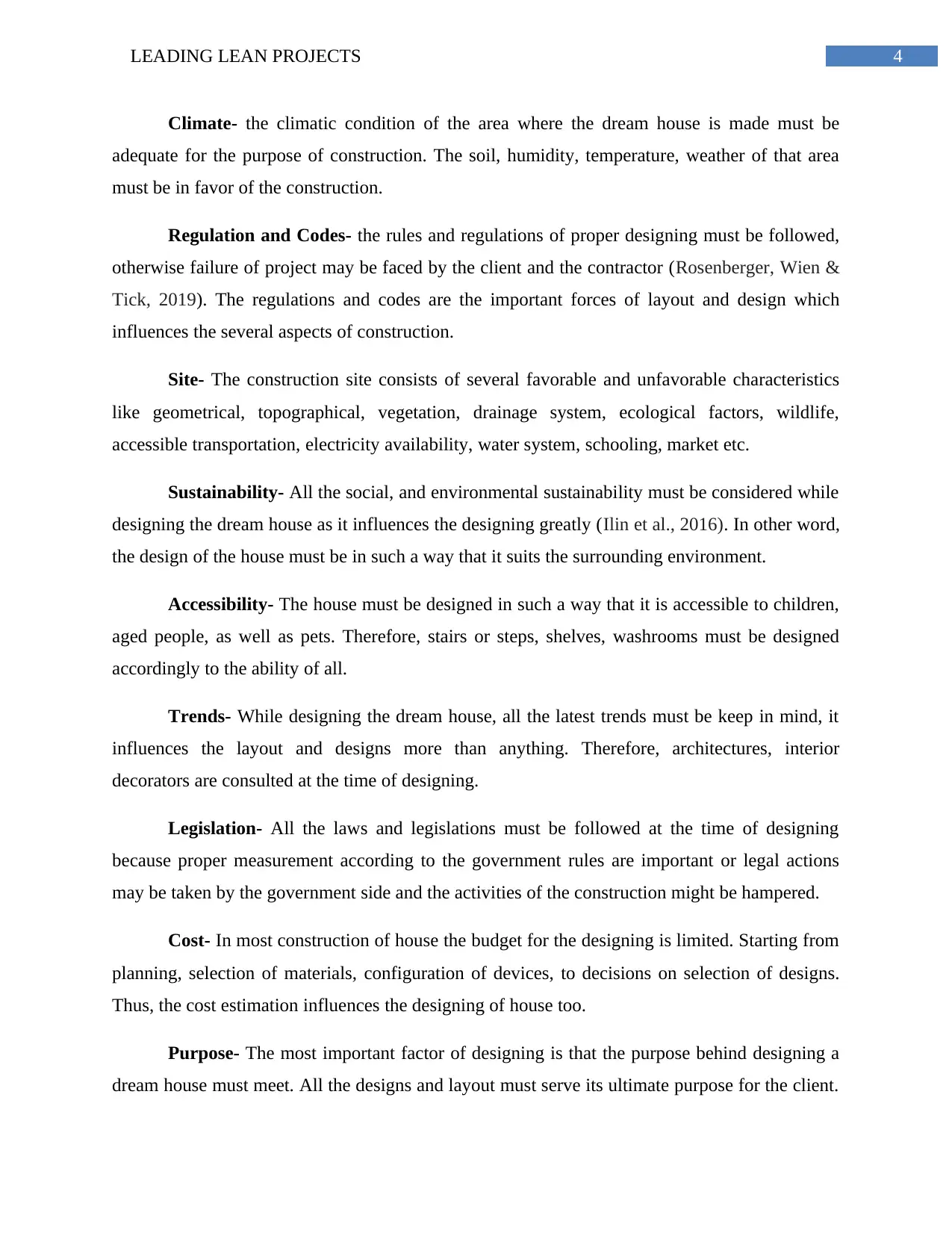
4LEADING LEAN PROJECTS
Climate- the climatic condition of the area where the dream house is made must be
adequate for the purpose of construction. The soil, humidity, temperature, weather of that area
must be in favor of the construction.
Regulation and Codes- the rules and regulations of proper designing must be followed,
otherwise failure of project may be faced by the client and the contractor (Rosenberger, Wien &
Tick, 2019). The regulations and codes are the important forces of layout and design which
influences the several aspects of construction.
Site- The construction site consists of several favorable and unfavorable characteristics
like geometrical, topographical, vegetation, drainage system, ecological factors, wildlife,
accessible transportation, electricity availability, water system, schooling, market etc.
Sustainability- All the social, and environmental sustainability must be considered while
designing the dream house as it influences the designing greatly (Ilin et al., 2016). In other word,
the design of the house must be in such a way that it suits the surrounding environment.
Accessibility- The house must be designed in such a way that it is accessible to children,
aged people, as well as pets. Therefore, stairs or steps, shelves, washrooms must be designed
accordingly to the ability of all.
Trends- While designing the dream house, all the latest trends must be keep in mind, it
influences the layout and designs more than anything. Therefore, architectures, interior
decorators are consulted at the time of designing.
Legislation- All the laws and legislations must be followed at the time of designing
because proper measurement according to the government rules are important or legal actions
may be taken by the government side and the activities of the construction might be hampered.
Cost- In most construction of house the budget for the designing is limited. Starting from
planning, selection of materials, configuration of devices, to decisions on selection of designs.
Thus, the cost estimation influences the designing of house too.
Purpose- The most important factor of designing is that the purpose behind designing a
dream house must meet. All the designs and layout must serve its ultimate purpose for the client.
Climate- the climatic condition of the area where the dream house is made must be
adequate for the purpose of construction. The soil, humidity, temperature, weather of that area
must be in favor of the construction.
Regulation and Codes- the rules and regulations of proper designing must be followed,
otherwise failure of project may be faced by the client and the contractor (Rosenberger, Wien &
Tick, 2019). The regulations and codes are the important forces of layout and design which
influences the several aspects of construction.
Site- The construction site consists of several favorable and unfavorable characteristics
like geometrical, topographical, vegetation, drainage system, ecological factors, wildlife,
accessible transportation, electricity availability, water system, schooling, market etc.
Sustainability- All the social, and environmental sustainability must be considered while
designing the dream house as it influences the designing greatly (Ilin et al., 2016). In other word,
the design of the house must be in such a way that it suits the surrounding environment.
Accessibility- The house must be designed in such a way that it is accessible to children,
aged people, as well as pets. Therefore, stairs or steps, shelves, washrooms must be designed
accordingly to the ability of all.
Trends- While designing the dream house, all the latest trends must be keep in mind, it
influences the layout and designs more than anything. Therefore, architectures, interior
decorators are consulted at the time of designing.
Legislation- All the laws and legislations must be followed at the time of designing
because proper measurement according to the government rules are important or legal actions
may be taken by the government side and the activities of the construction might be hampered.
Cost- In most construction of house the budget for the designing is limited. Starting from
planning, selection of materials, configuration of devices, to decisions on selection of designs.
Thus, the cost estimation influences the designing of house too.
Purpose- The most important factor of designing is that the purpose behind designing a
dream house must meet. All the designs and layout must serve its ultimate purpose for the client.
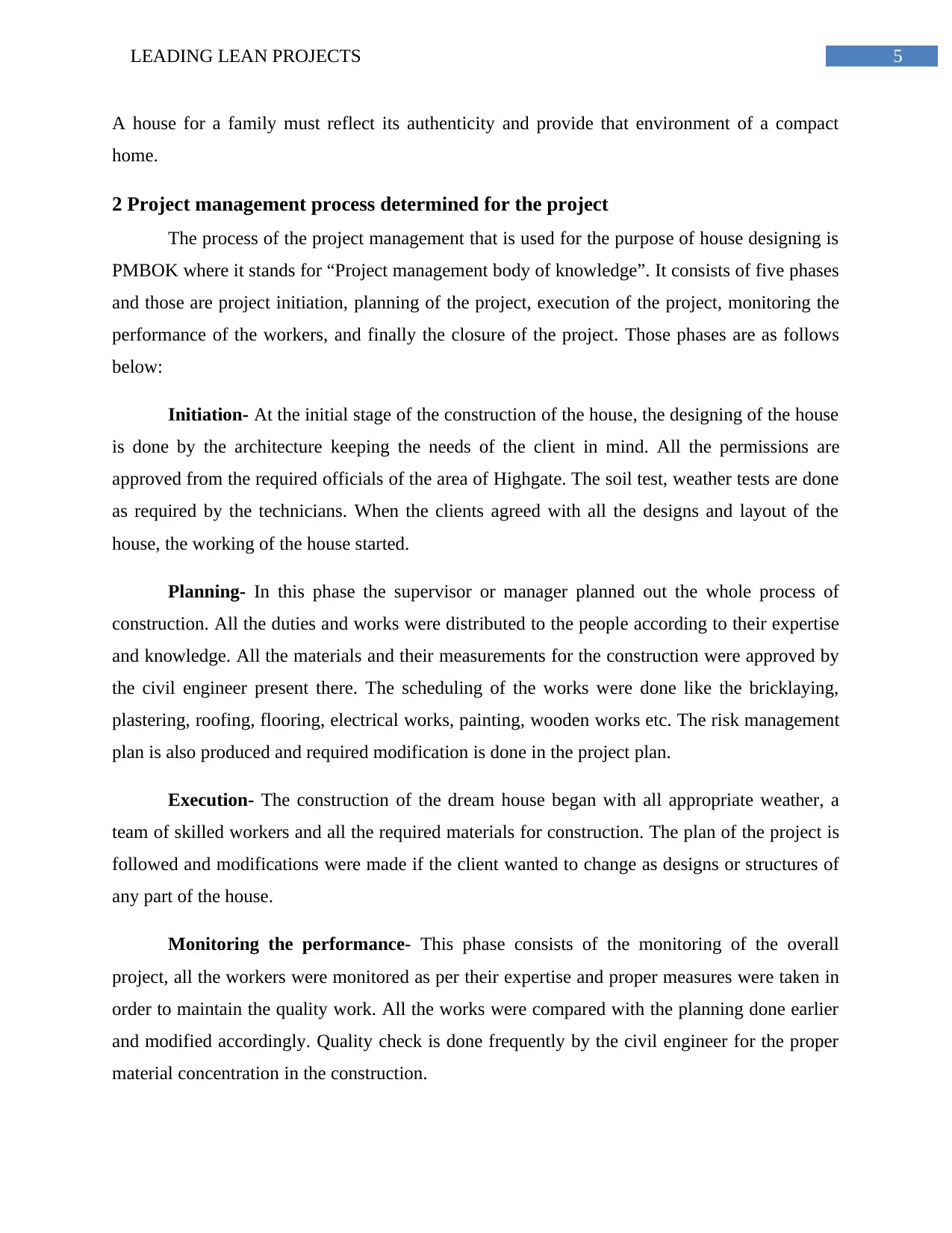
5LEADING LEAN PROJECTS
A house for a family must reflect its authenticity and provide that environment of a compact
home.
2 Project management process determined for the project
The process of the project management that is used for the purpose of house designing is
PMBOK where it stands for “Project management body of knowledge”. It consists of five phases
and those are project initiation, planning of the project, execution of the project, monitoring the
performance of the workers, and finally the closure of the project. Those phases are as follows
below:
Initiation- At the initial stage of the construction of the house, the designing of the house
is done by the architecture keeping the needs of the client in mind. All the permissions are
approved from the required officials of the area of Highgate. The soil test, weather tests are done
as required by the technicians. When the clients agreed with all the designs and layout of the
house, the working of the house started.
Planning- In this phase the supervisor or manager planned out the whole process of
construction. All the duties and works were distributed to the people according to their expertise
and knowledge. All the materials and their measurements for the construction were approved by
the civil engineer present there. The scheduling of the works were done like the bricklaying,
plastering, roofing, flooring, electrical works, painting, wooden works etc. The risk management
plan is also produced and required modification is done in the project plan.
Execution- The construction of the dream house began with all appropriate weather, a
team of skilled workers and all the required materials for construction. The plan of the project is
followed and modifications were made if the client wanted to change as designs or structures of
any part of the house.
Monitoring the performance- This phase consists of the monitoring of the overall
project, all the workers were monitored as per their expertise and proper measures were taken in
order to maintain the quality work. All the works were compared with the planning done earlier
and modified accordingly. Quality check is done frequently by the civil engineer for the proper
material concentration in the construction.
A house for a family must reflect its authenticity and provide that environment of a compact
home.
2 Project management process determined for the project
The process of the project management that is used for the purpose of house designing is
PMBOK where it stands for “Project management body of knowledge”. It consists of five phases
and those are project initiation, planning of the project, execution of the project, monitoring the
performance of the workers, and finally the closure of the project. Those phases are as follows
below:
Initiation- At the initial stage of the construction of the house, the designing of the house
is done by the architecture keeping the needs of the client in mind. All the permissions are
approved from the required officials of the area of Highgate. The soil test, weather tests are done
as required by the technicians. When the clients agreed with all the designs and layout of the
house, the working of the house started.
Planning- In this phase the supervisor or manager planned out the whole process of
construction. All the duties and works were distributed to the people according to their expertise
and knowledge. All the materials and their measurements for the construction were approved by
the civil engineer present there. The scheduling of the works were done like the bricklaying,
plastering, roofing, flooring, electrical works, painting, wooden works etc. The risk management
plan is also produced and required modification is done in the project plan.
Execution- The construction of the dream house began with all appropriate weather, a
team of skilled workers and all the required materials for construction. The plan of the project is
followed and modifications were made if the client wanted to change as designs or structures of
any part of the house.
Monitoring the performance- This phase consists of the monitoring of the overall
project, all the workers were monitored as per their expertise and proper measures were taken in
order to maintain the quality work. All the works were compared with the planning done earlier
and modified accordingly. Quality check is done frequently by the civil engineer for the proper
material concentration in the construction.
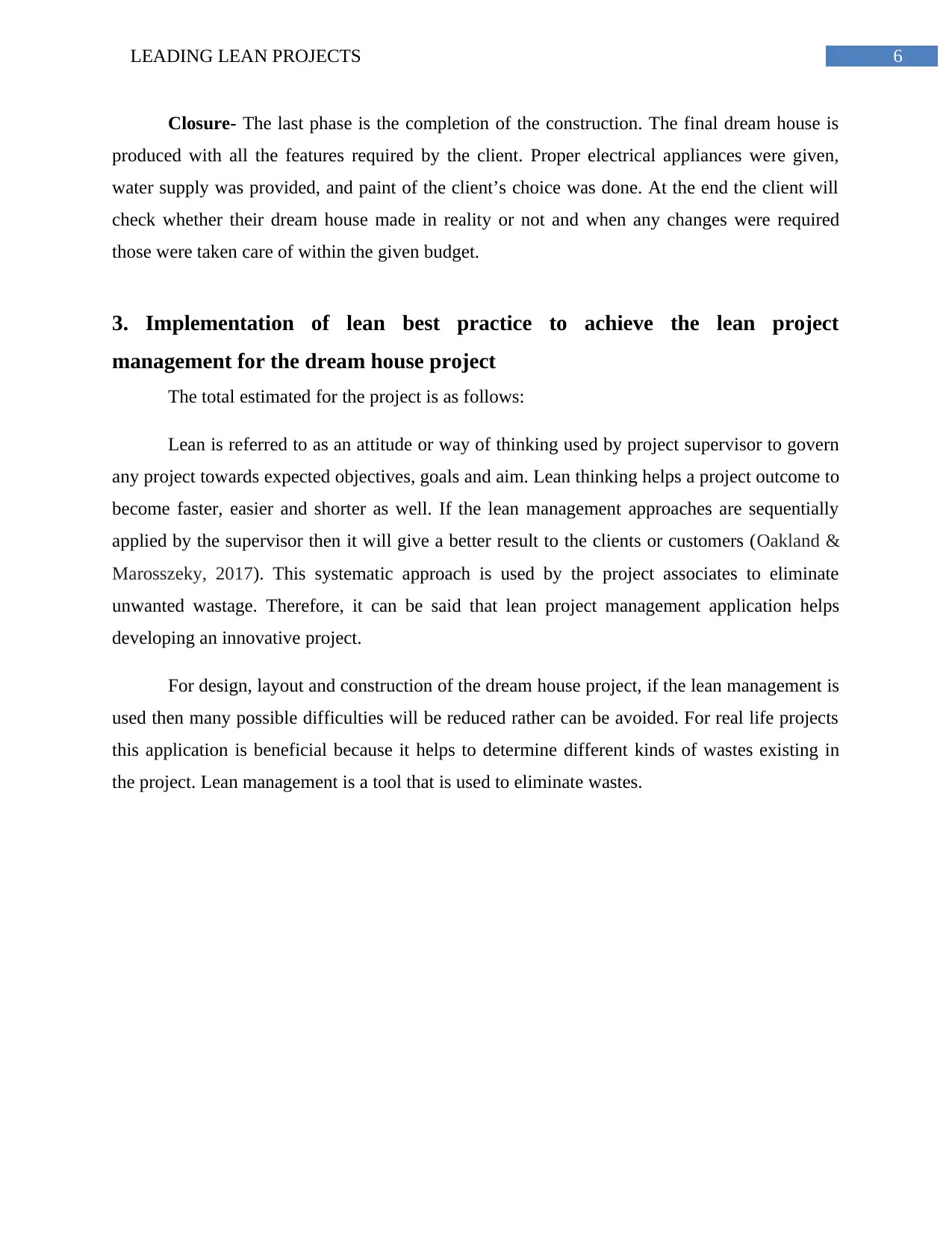
6LEADING LEAN PROJECTS
Closure- The last phase is the completion of the construction. The final dream house is
produced with all the features required by the client. Proper electrical appliances were given,
water supply was provided, and paint of the client’s choice was done. At the end the client will
check whether their dream house made in reality or not and when any changes were required
those were taken care of within the given budget.
3. Implementation of lean best practice to achieve the lean project
management for the dream house project
The total estimated for the project is as follows:
Lean is referred to as an attitude or way of thinking used by project supervisor to govern
any project towards expected objectives, goals and aim. Lean thinking helps a project outcome to
become faster, easier and shorter as well. If the lean management approaches are sequentially
applied by the supervisor then it will give a better result to the clients or customers (Oakland &
Marosszeky, 2017). This systematic approach is used by the project associates to eliminate
unwanted wastage. Therefore, it can be said that lean project management application helps
developing an innovative project.
For design, layout and construction of the dream house project, if the lean management is
used then many possible difficulties will be reduced rather can be avoided. For real life projects
this application is beneficial because it helps to determine different kinds of wastes existing in
the project. Lean management is a tool that is used to eliminate wastes.
Closure- The last phase is the completion of the construction. The final dream house is
produced with all the features required by the client. Proper electrical appliances were given,
water supply was provided, and paint of the client’s choice was done. At the end the client will
check whether their dream house made in reality or not and when any changes were required
those were taken care of within the given budget.
3. Implementation of lean best practice to achieve the lean project
management for the dream house project
The total estimated for the project is as follows:
Lean is referred to as an attitude or way of thinking used by project supervisor to govern
any project towards expected objectives, goals and aim. Lean thinking helps a project outcome to
become faster, easier and shorter as well. If the lean management approaches are sequentially
applied by the supervisor then it will give a better result to the clients or customers (Oakland &
Marosszeky, 2017). This systematic approach is used by the project associates to eliminate
unwanted wastage. Therefore, it can be said that lean project management application helps
developing an innovative project.
For design, layout and construction of the dream house project, if the lean management is
used then many possible difficulties will be reduced rather can be avoided. For real life projects
this application is beneficial because it helps to determine different kinds of wastes existing in
the project. Lean management is a tool that is used to eliminate wastes.
Paraphrase This Document
Need a fresh take? Get an instant paraphrase of this document with our AI Paraphraser

7LEADING LEAN PROJECTS
Figure 1: Project budget
(Source: Created by author)
In other words, it can be said that, lean management is a process used for process
optimization and waste elimination (Ansah, Sorooshian & Mustafa, 2016). For construction of
dream house, how lean project management can be applied is elaborated in below section:
Identification of Value: At the initiation of dream house construction firstly project
values should be identified. In these stage construction requirements, objectives, goals and other
project specifications are identified. The project values will be identified once the customer will
be ready to pay needful for the project. After that the builder should define values based on
customer’s requirements in terms of design and construction layout details. It has been identified
that the estimated project budget and time are not well balanced and also the initial identified
resources are not effective (Jamil & Fathi, 2016). The solution will identify customer
requirements and estimate the amount that the company will pay for successful execution of the
Figure 1: Project budget
(Source: Created by author)
In other words, it can be said that, lean management is a process used for process
optimization and waste elimination (Ansah, Sorooshian & Mustafa, 2016). For construction of
dream house, how lean project management can be applied is elaborated in below section:
Identification of Value: At the initiation of dream house construction firstly project
values should be identified. In these stage construction requirements, objectives, goals and other
project specifications are identified. The project values will be identified once the customer will
be ready to pay needful for the project. After that the builder should define values based on
customer’s requirements in terms of design and construction layout details. It has been identified
that the estimated project budget and time are not well balanced and also the initial identified
resources are not effective (Jamil & Fathi, 2016). The solution will identify customer
requirements and estimate the amount that the company will pay for successful execution of the
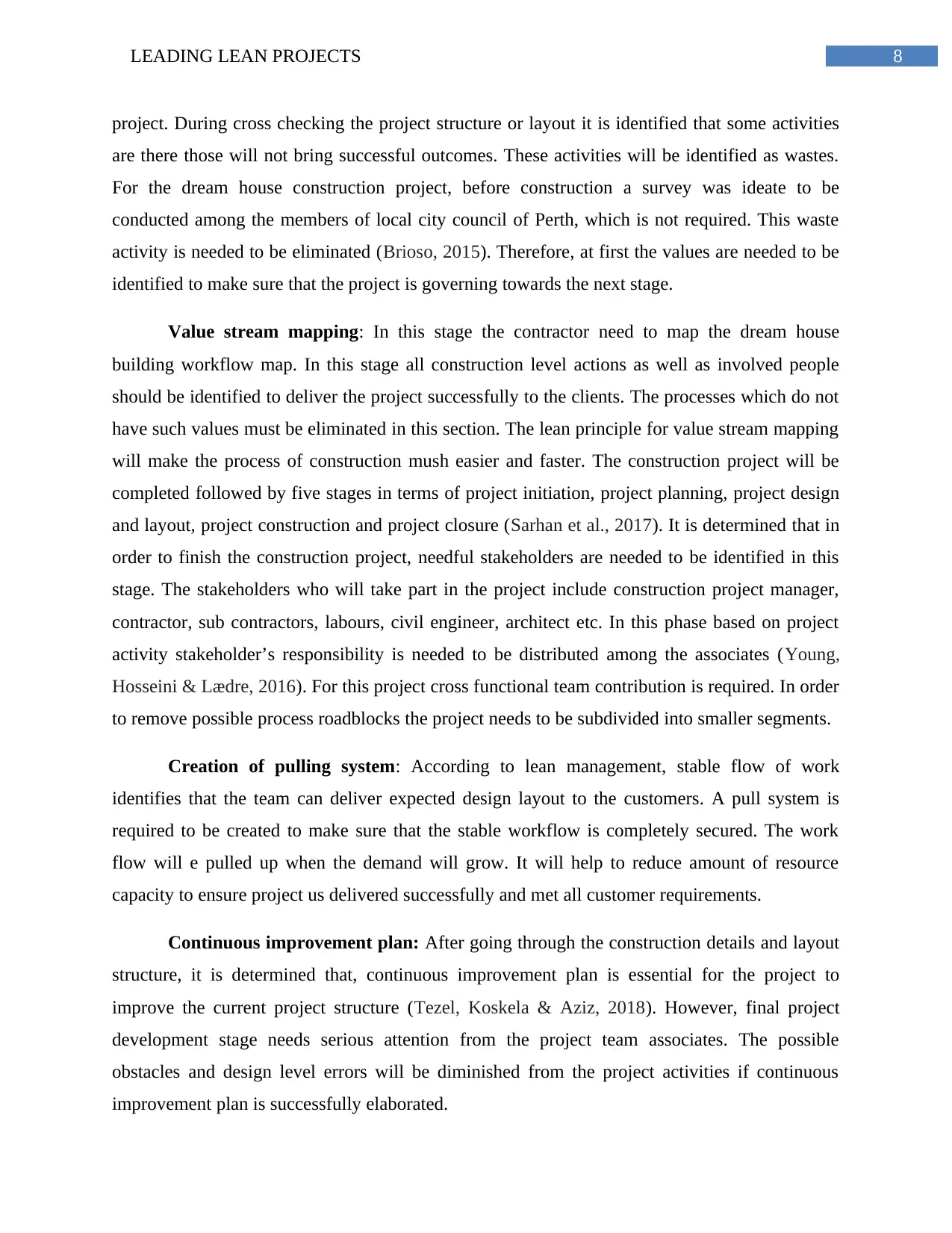
8LEADING LEAN PROJECTS
project. During cross checking the project structure or layout it is identified that some activities
are there those will not bring successful outcomes. These activities will be identified as wastes.
For the dream house construction project, before construction a survey was ideate to be
conducted among the members of local city council of Perth, which is not required. This waste
activity is needed to be eliminated (Brioso, 2015). Therefore, at first the values are needed to be
identified to make sure that the project is governing towards the next stage.
Value stream mapping: In this stage the contractor need to map the dream house
building workflow map. In this stage all construction level actions as well as involved people
should be identified to deliver the project successfully to the clients. The processes which do not
have such values must be eliminated in this section. The lean principle for value stream mapping
will make the process of construction mush easier and faster. The construction project will be
completed followed by five stages in terms of project initiation, project planning, project design
and layout, project construction and project closure (Sarhan et al., 2017). It is determined that in
order to finish the construction project, needful stakeholders are needed to be identified in this
stage. The stakeholders who will take part in the project include construction project manager,
contractor, sub contractors, labours, civil engineer, architect etc. In this phase based on project
activity stakeholder’s responsibility is needed to be distributed among the associates (Young,
Hosseini & Lædre, 2016). For this project cross functional team contribution is required. In order
to remove possible process roadblocks the project needs to be subdivided into smaller segments.
Creation of pulling system: According to lean management, stable flow of work
identifies that the team can deliver expected design layout to the customers. A pull system is
required to be created to make sure that the stable workflow is completely secured. The work
flow will e pulled up when the demand will grow. It will help to reduce amount of resource
capacity to ensure project us delivered successfully and met all customer requirements.
Continuous improvement plan: After going through the construction details and layout
structure, it is determined that, continuous improvement plan is essential for the project to
improve the current project structure (Tezel, Koskela & Aziz, 2018). However, final project
development stage needs serious attention from the project team associates. The possible
obstacles and design level errors will be diminished from the project activities if continuous
improvement plan is successfully elaborated.
project. During cross checking the project structure or layout it is identified that some activities
are there those will not bring successful outcomes. These activities will be identified as wastes.
For the dream house construction project, before construction a survey was ideate to be
conducted among the members of local city council of Perth, which is not required. This waste
activity is needed to be eliminated (Brioso, 2015). Therefore, at first the values are needed to be
identified to make sure that the project is governing towards the next stage.
Value stream mapping: In this stage the contractor need to map the dream house
building workflow map. In this stage all construction level actions as well as involved people
should be identified to deliver the project successfully to the clients. The processes which do not
have such values must be eliminated in this section. The lean principle for value stream mapping
will make the process of construction mush easier and faster. The construction project will be
completed followed by five stages in terms of project initiation, project planning, project design
and layout, project construction and project closure (Sarhan et al., 2017). It is determined that in
order to finish the construction project, needful stakeholders are needed to be identified in this
stage. The stakeholders who will take part in the project include construction project manager,
contractor, sub contractors, labours, civil engineer, architect etc. In this phase based on project
activity stakeholder’s responsibility is needed to be distributed among the associates (Young,
Hosseini & Lædre, 2016). For this project cross functional team contribution is required. In order
to remove possible process roadblocks the project needs to be subdivided into smaller segments.
Creation of pulling system: According to lean management, stable flow of work
identifies that the team can deliver expected design layout to the customers. A pull system is
required to be created to make sure that the stable workflow is completely secured. The work
flow will e pulled up when the demand will grow. It will help to reduce amount of resource
capacity to ensure project us delivered successfully and met all customer requirements.
Continuous improvement plan: After going through the construction details and layout
structure, it is determined that, continuous improvement plan is essential for the project to
improve the current project structure (Tezel, Koskela & Aziz, 2018). However, final project
development stage needs serious attention from the project team associates. The possible
obstacles and design level errors will be diminished from the project activities if continuous
improvement plan is successfully elaborated.
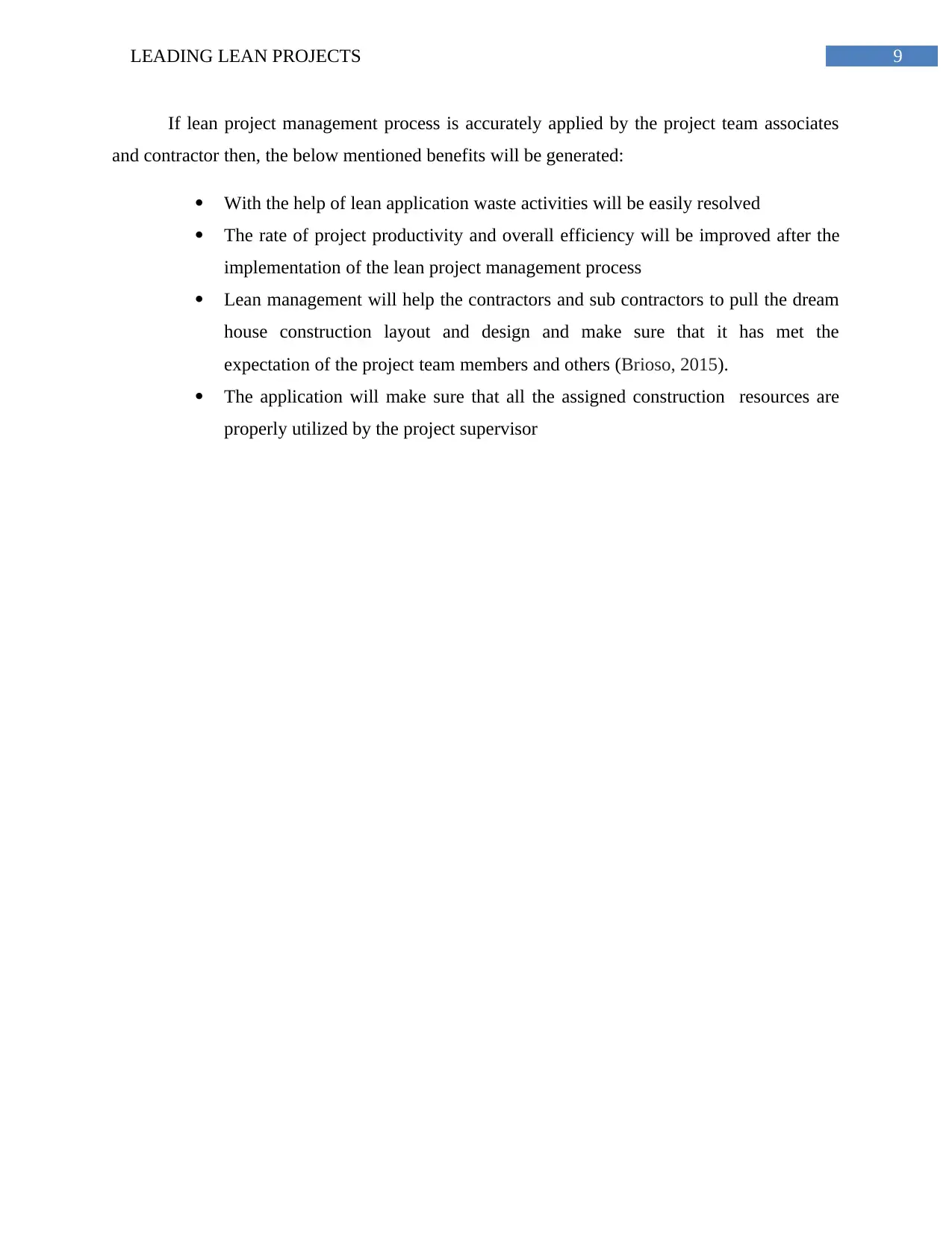
9LEADING LEAN PROJECTS
If lean project management process is accurately applied by the project team associates
and contractor then, the below mentioned benefits will be generated:
With the help of lean application waste activities will be easily resolved
The rate of project productivity and overall efficiency will be improved after the
implementation of the lean project management process
Lean management will help the contractors and sub contractors to pull the dream
house construction layout and design and make sure that it has met the
expectation of the project team members and others (Brioso, 2015).
The application will make sure that all the assigned construction resources are
properly utilized by the project supervisor
If lean project management process is accurately applied by the project team associates
and contractor then, the below mentioned benefits will be generated:
With the help of lean application waste activities will be easily resolved
The rate of project productivity and overall efficiency will be improved after the
implementation of the lean project management process
Lean management will help the contractors and sub contractors to pull the dream
house construction layout and design and make sure that it has met the
expectation of the project team members and others (Brioso, 2015).
The application will make sure that all the assigned construction resources are
properly utilized by the project supervisor
Secure Best Marks with AI Grader
Need help grading? Try our AI Grader for instant feedback on your assignments.
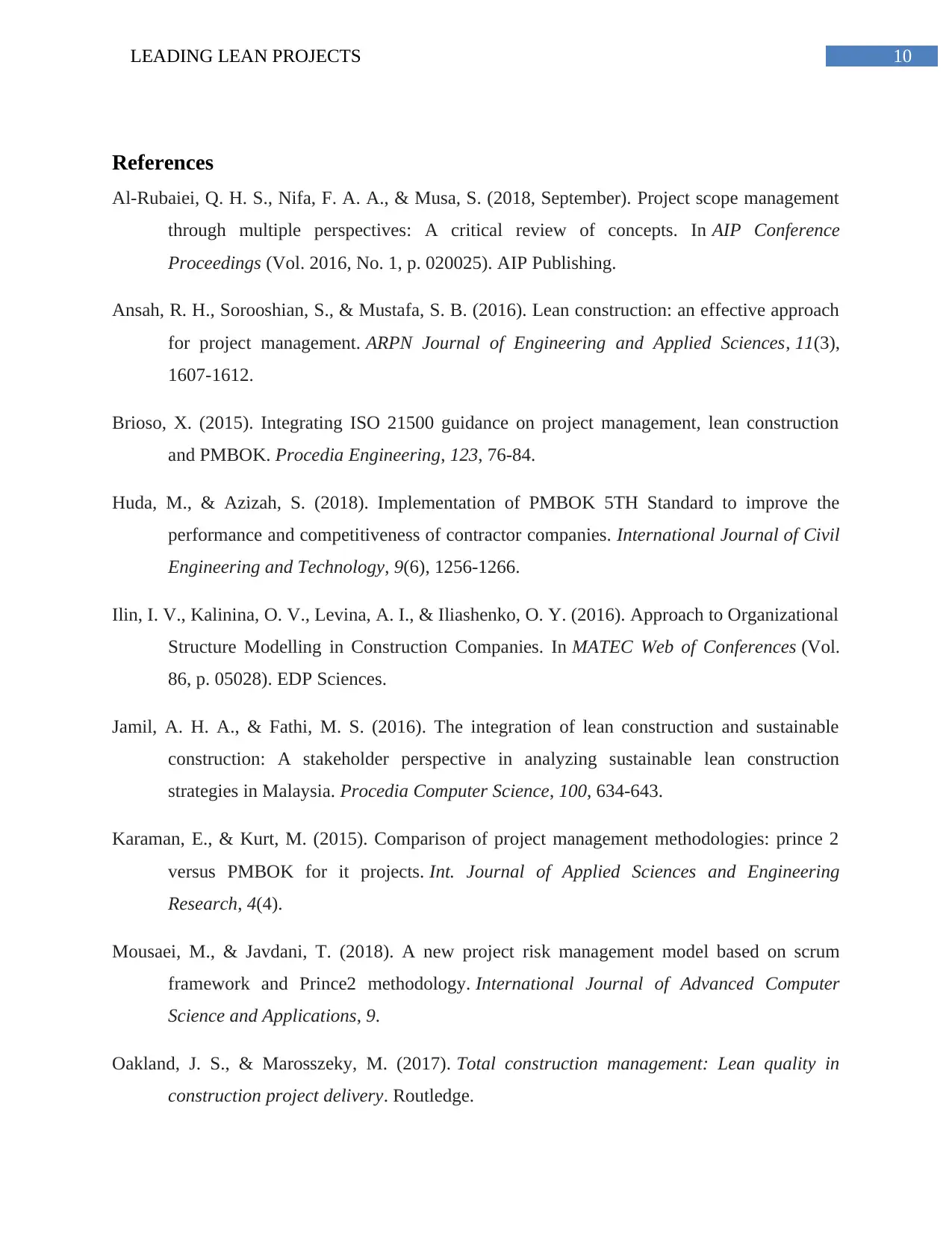
10LEADING LEAN PROJECTS
References
Al-Rubaiei, Q. H. S., Nifa, F. A. A., & Musa, S. (2018, September). Project scope management
through multiple perspectives: A critical review of concepts. In AIP Conference
Proceedings (Vol. 2016, No. 1, p. 020025). AIP Publishing.
Ansah, R. H., Sorooshian, S., & Mustafa, S. B. (2016). Lean construction: an effective approach
for project management. ARPN Journal of Engineering and Applied Sciences, 11(3),
1607-1612.
Brioso, X. (2015). Integrating ISO 21500 guidance on project management, lean construction
and PMBOK. Procedia Engineering, 123, 76-84.
Huda, M., & Azizah, S. (2018). Implementation of PMBOK 5TH Standard to improve the
performance and competitiveness of contractor companies. International Journal of Civil
Engineering and Technology, 9(6), 1256-1266.
Ilin, I. V., Kalinina, O. V., Levina, A. I., & Iliashenko, O. Y. (2016). Approach to Organizational
Structure Modelling in Construction Companies. In MATEC Web of Conferences (Vol.
86, p. 05028). EDP Sciences.
Jamil, A. H. A., & Fathi, M. S. (2016). The integration of lean construction and sustainable
construction: A stakeholder perspective in analyzing sustainable lean construction
strategies in Malaysia. Procedia Computer Science, 100, 634-643.
Karaman, E., & Kurt, M. (2015). Comparison of project management methodologies: prince 2
versus PMBOK for it projects. Int. Journal of Applied Sciences and Engineering
Research, 4(4).
Mousaei, M., & Javdani, T. (2018). A new project risk management model based on scrum
framework and Prince2 methodology. International Journal of Advanced Computer
Science and Applications, 9.
Oakland, J. S., & Marosszeky, M. (2017). Total construction management: Lean quality in
construction project delivery. Routledge.
References
Al-Rubaiei, Q. H. S., Nifa, F. A. A., & Musa, S. (2018, September). Project scope management
through multiple perspectives: A critical review of concepts. In AIP Conference
Proceedings (Vol. 2016, No. 1, p. 020025). AIP Publishing.
Ansah, R. H., Sorooshian, S., & Mustafa, S. B. (2016). Lean construction: an effective approach
for project management. ARPN Journal of Engineering and Applied Sciences, 11(3),
1607-1612.
Brioso, X. (2015). Integrating ISO 21500 guidance on project management, lean construction
and PMBOK. Procedia Engineering, 123, 76-84.
Huda, M., & Azizah, S. (2018). Implementation of PMBOK 5TH Standard to improve the
performance and competitiveness of contractor companies. International Journal of Civil
Engineering and Technology, 9(6), 1256-1266.
Ilin, I. V., Kalinina, O. V., Levina, A. I., & Iliashenko, O. Y. (2016). Approach to Organizational
Structure Modelling in Construction Companies. In MATEC Web of Conferences (Vol.
86, p. 05028). EDP Sciences.
Jamil, A. H. A., & Fathi, M. S. (2016). The integration of lean construction and sustainable
construction: A stakeholder perspective in analyzing sustainable lean construction
strategies in Malaysia. Procedia Computer Science, 100, 634-643.
Karaman, E., & Kurt, M. (2015). Comparison of project management methodologies: prince 2
versus PMBOK for it projects. Int. Journal of Applied Sciences and Engineering
Research, 4(4).
Mousaei, M., & Javdani, T. (2018). A new project risk management model based on scrum
framework and Prince2 methodology. International Journal of Advanced Computer
Science and Applications, 9.
Oakland, J. S., & Marosszeky, M. (2017). Total construction management: Lean quality in
construction project delivery. Routledge.
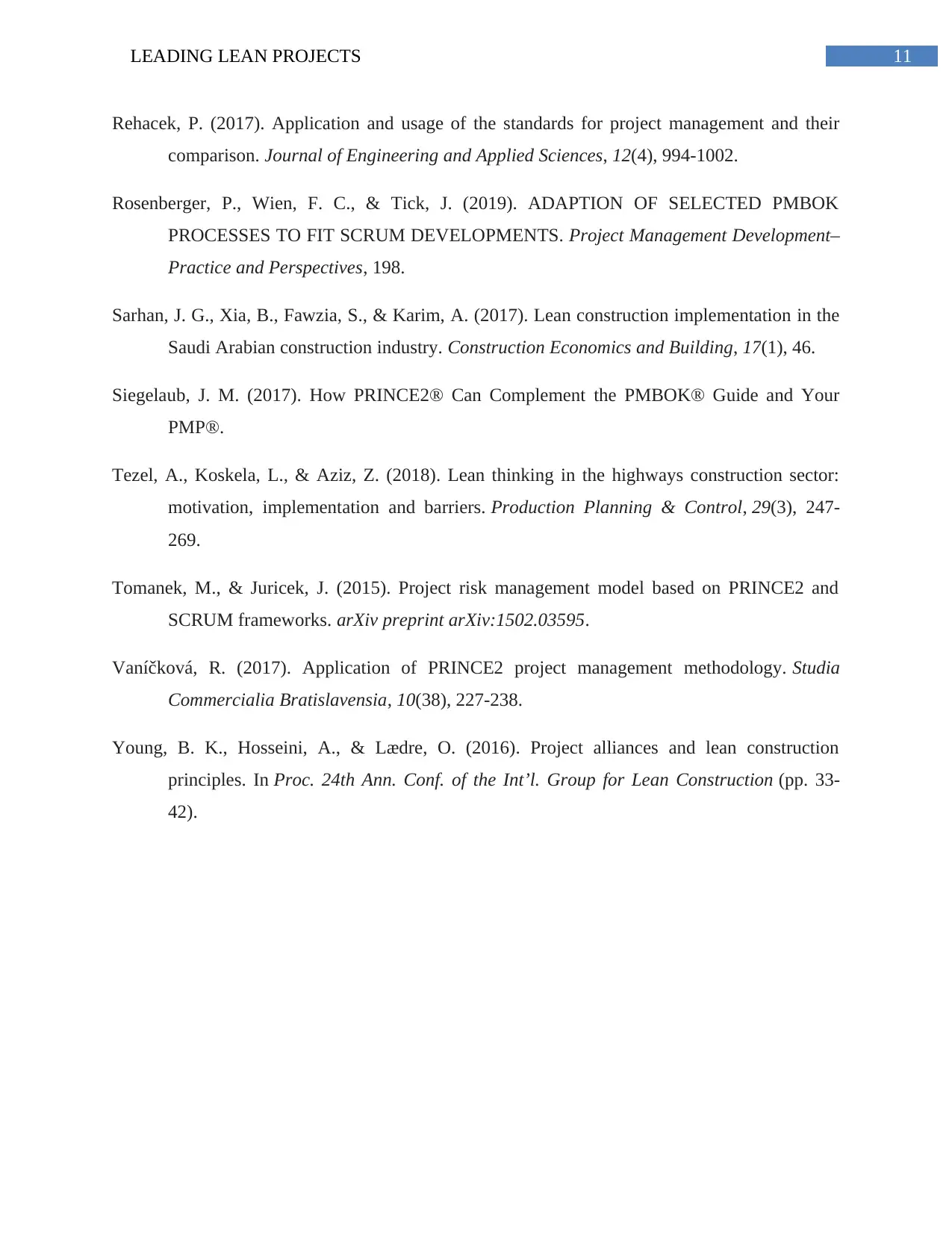
11LEADING LEAN PROJECTS
Rehacek, P. (2017). Application and usage of the standards for project management and their
comparison. Journal of Engineering and Applied Sciences, 12(4), 994-1002.
Rosenberger, P., Wien, F. C., & Tick, J. (2019). ADAPTION OF SELECTED PMBOK
PROCESSES TO FIT SCRUM DEVELOPMENTS. Project Management Development–
Practice and Perspectives, 198.
Sarhan, J. G., Xia, B., Fawzia, S., & Karim, A. (2017). Lean construction implementation in the
Saudi Arabian construction industry. Construction Economics and Building, 17(1), 46.
Siegelaub, J. M. (2017). How PRINCE2® Can Complement the PMBOK® Guide and Your
PMP®.
Tezel, A., Koskela, L., & Aziz, Z. (2018). Lean thinking in the highways construction sector:
motivation, implementation and barriers. Production Planning & Control, 29(3), 247-
269.
Tomanek, M., & Juricek, J. (2015). Project risk management model based on PRINCE2 and
SCRUM frameworks. arXiv preprint arXiv:1502.03595.
Vaníčková, R. (2017). Application of PRINCE2 project management methodology. Studia
Commercialia Bratislavensia, 10(38), 227-238.
Young, B. K., Hosseini, A., & Lædre, O. (2016). Project alliances and lean construction
principles. In Proc. 24th Ann. Conf. of the Int’l. Group for Lean Construction (pp. 33-
42).
Rehacek, P. (2017). Application and usage of the standards for project management and their
comparison. Journal of Engineering and Applied Sciences, 12(4), 994-1002.
Rosenberger, P., Wien, F. C., & Tick, J. (2019). ADAPTION OF SELECTED PMBOK
PROCESSES TO FIT SCRUM DEVELOPMENTS. Project Management Development–
Practice and Perspectives, 198.
Sarhan, J. G., Xia, B., Fawzia, S., & Karim, A. (2017). Lean construction implementation in the
Saudi Arabian construction industry. Construction Economics and Building, 17(1), 46.
Siegelaub, J. M. (2017). How PRINCE2® Can Complement the PMBOK® Guide and Your
PMP®.
Tezel, A., Koskela, L., & Aziz, Z. (2018). Lean thinking in the highways construction sector:
motivation, implementation and barriers. Production Planning & Control, 29(3), 247-
269.
Tomanek, M., & Juricek, J. (2015). Project risk management model based on PRINCE2 and
SCRUM frameworks. arXiv preprint arXiv:1502.03595.
Vaníčková, R. (2017). Application of PRINCE2 project management methodology. Studia
Commercialia Bratislavensia, 10(38), 227-238.
Young, B. K., Hosseini, A., & Lædre, O. (2016). Project alliances and lean construction
principles. In Proc. 24th Ann. Conf. of the Int’l. Group for Lean Construction (pp. 33-
42).
1 out of 12
Related Documents
Your All-in-One AI-Powered Toolkit for Academic Success.
+13062052269
info@desklib.com
Available 24*7 on WhatsApp / Email
![[object Object]](/_next/static/media/star-bottom.7253800d.svg)
Unlock your academic potential
© 2024 | Zucol Services PVT LTD | All rights reserved.





